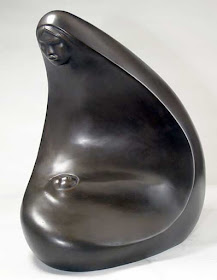Born on June 30, 1914, Allan C. Haozous was to become known as Allan Houser, one of the 20th Century's most important artists.(died August 22, 1994) Allan's parents, Sam and Blossom Haozous were members of the Chiricahua Apache tribe who were held as prisoners of war for 27 years. Allan's father was with the small band of Warm Springs Chiricahuas when their leader, Geronimo, surrendered to the U.S. Army in 1886 in the northern Mexican state of Chihuahua. Allan Houser's father, Sam Haozous, and Geronimo were first cousins. Their fathers, Goohah-hleenah and Taklishim, were both sons of the Bedonkohe Apache chief Mahko by his first wife. In retribution for the Warm Springs Bands' refusal to leave their lands in New Mexico and relocate to a reservation in Arizona, 1200 Chiricahuas were sent by cattle-car train to prisons in Florida.
Allan's father was among the women and children jailed at the Castillo de San Marcos in St. Augustine, Florida, and Allan's mother was born in the prison camp at the Mount Vernon Barracks, Alabama where surviving members of the tribe were sent in 1887. As a final solution, the last of the Chiricahuas were sent to Fort Sill, Oklahoma where they remained captives for 23 years. Freed at last in 1914, a majority of the tribe returned to New Mexico to join with the Mescalero Apaches for whom a reservation had been created. Allan's parents, however, were with a small group of families who chose to stay in Oklahoma and create farms in the Apache and Lawton communities. Allan was born just months after their release, the first child born out of captivity.
Growing up on the farm, Allan labored with crops of cotton and alfalfa and helped support the family growing vegetables and raising livestock and horses. At an early age he became interested in the images he saw in magazines and books. He soon began making his own drawings and carvings. In 1934 a notice for an art school in Santa Fe attracted his attention, and he enrolled in the Painting School at the Santa Fe Indian School. Commonly known as the Dorothy Dunn School after its prominent teacher, Allan became its most famous student and by 1939 his work was exhibited in San Francisco, Washington D. C., and Chicago. In the same year he received a commission to paint a mural in the Department of Interior building in Washington, and its success led to a second mural commission there in 1940.
In 1947 Allan was commissioned by the Haskell Institute in Lawrence, Kansas, to do a memorial sculpture honoring the Native American students from Haskell who had died in World War II. Completed in 1948, this work entitled "Comrade in Mourning" was his first major marble carving. In 1951 Allan moved to Brigham City, Utah, where he taught art at the Inter-Mountain Indian School for the next eleven years. He continued to paint and produce small wooden sculptures, and in 1954 he was honored by the French government with the Palmes d'Acadamique for his outstanding achievement as a teacher and artist.
In 1962 Allan was asked to join the faculty of the newly created Institute of American Indian Arts in Santa Fe. There he created the sculpture department and began focusing his own artistic output on three-dimensional work. As he taught and created sculpture he began integrating the aesthetics of the modernists with his narrative ideas. By the late 1960's he began exhibiting this sculpture and recognition of his unique style grew. Museums and private collectors sought out examples, and his influence became apparent on hundreds of students and other artists. In 1975 Allan retired from teaching to devote himself full-time to his own work. In the two following decades he would produce close to 1,000 sculptures in stone, wood, and bronze, and emerged as a major figure on an international scale. He had nearly 50 solo exhibitions in museums and galleries in the United States, Europe, and Asia (allanhouser.com)









No comments:
Post a Comment